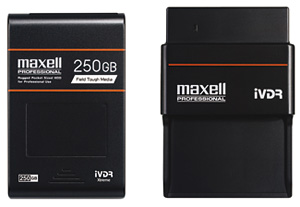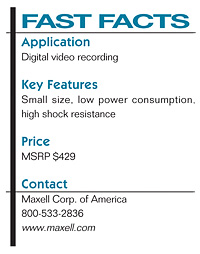Maxell iVDR-Xtreme
The concept of iVDR (Information Versatile Disk for Removable usage) originated with a consortium of Japanese manufacturers to provide consumers with a highly portable, ubiquitous method for carrying, viewing or transferring data in the high-definition age. Maxell’s iVDR-Xtreme takes this concept and hones it for professional video production applications.
As part of its recording media expansion, Maxell has introduced an ultra-compact disk drive boasting high transfer speeds and a shock-resistant design based on iVDR technology. The Maxell iVDR-Xtreme consists of a housing that contains FireWire 800 and USB 2.0 interfaces, and accepts 250 GB disk drive cartridges. It is ideally suited for off-loading the contents of Panasonic P2 cards in the field; however, being a regularly formatted disk drive, it could be used for any form of data transfer.

The Maxell iVDR-XtremeFEATURES
The current Maxell iVDR-Xtreme is 250 GB disk drive that measures only 5 x 3-inches and weighs a mere six ounces. It has a two-stage design, which allows one to carry more media without duplicating the interface. The slim 250 GB disk drive cartridges plug into a slightly larger plastic sleeve that provides the connectivity to the real world, along with an AC plug. However, the drive has very low power consumption, which allows it to be powered from the laptop or desk computer it’s connected to, so the AC adapter is rarely needed.
The drive comes pre-formatted in FAT 32, which is both Mac and PC compatible. However, the iVDR-Xtreme functions like a normal disk drive and can be formatted to any file system the user desires.
Now there are many ultra-compact disk drives on the market—what makes Maxell’s iVDR-Xtreme unique is that it’s designed for rugged field use, fast transfer speeds, and has minimal weight and bulk due to the two-stage design. The iVDR can handle operational shock up to 350 Gs (equal to about a 4.6 foot drop onto concrete), and can function in temperatures ranging from 32 to 122 degrees Fahrenheit. The disk drive has a 5400 rpm spindle speed and an 8 MB cache. The FireWire 800 and USB 2.0 connections offer transfer speeds that match or exceed most typical internal drives.
The Maxell iVDR-Xtreme connects easily to laptops, desk computers, editing hardware and even some cameras, without any additional software. As such, one can use it to transfer data from certain Panasonic P2 video cameras that provide a “host” mode, or connect it to a laptop to mediate the transfer of memory card contents.
IN USE
As the Maxell iVDR-Xtreme is designed for field production use, I decided to test its efficiency in a Panasonic P2 memory card workflow. However, the same workflow could be applied to any video capture system that uses memory cards.
The problem with shooting on memory card media is that unless you’re working in one of the highly compressed formats, such as AVCHD (which can record on cheap SD cards), you need to use more costly media such as Panasonic P2 cards. These are still a bit pricy to buy in the quantity desired by many shooters, so one solution is to transfer the P2 card contents in the field, thus allowing you to refresh the cards and shoot again.
Using a Panasonic HVX200, I shot enough HD footage to fill one 8 GB P2 card, and then tested the ease and speed of transfer to the Maxell iVDR-Xtreme. My workflow was to take the full P2 card from the camera, plug it into a PCMCIA slot on my laptop, and then transfer the contents to the Maxell iVDR-Xtreme. (One thing to remember is that you must install the Panasonic P2 driver so that Windows or Mac will recognize the P2 card as an external drive.)
The first thing I discovered is that my six-year-old Toshiba Satellite laptop is now too out of date for such a task. It only has a mini FireWire 400 port, and it has USB 1.0, which is impossibly slow for this type of data transfer. I had an issue with my FireWire 400 connection, but I did manage to move the contents of the 8 GB P2 card onto the Maxell iVDR-Xtreme through the USB 1.0 connection. This took 45 minutes, illustrating the inefficiency of USB 1.0.
The good news is that any newer laptop with the right connections will work perfectly. I borrowed a relatively new Dell Inspiron 9100 and tried again. Although still a couple of years old, this one did have USB 2.0 and pretty beefy processing speed, running a Pentium 4 2.8 GHz processor.
First, I installed the Panasonic P2 driver. Then I plugged the P2 card in and made sure that Windows recognized it. I connected the Maxell iVDR-Xtreme to the FireWire 400 port on the laptop using a 9-pin to 4-pin adapter, but the laptop failed to recognize the drive. I was later informed that I had a pre-production model that had this problem and that the final shipping units are completely compatible with FireWire 400 and 800. Although I was unable to test the FireWire performance of the Maxell iVDR-Xtreme, I was able to test the transfer speed over USB 2.0.

Using the USB 2.0 port on the Dell Inspiron, I was able to transfer the contents of my 8GB P2 card to the Maxell iVDR-Xtreme in only five minutes and 40 seconds. Overall transfer speed will be affected by the processing speed of the laptop. However, most of the newer laptops should be able to deliver transfer speeds in this neighborhood.
Of course, you’re not going to want to keep the P2 contents on the Maxell iVDR-Xtreme forever, so the final step is to transfer the contents of the Maxell iVDR-Xtreme to a permanent storage disk. I tested the speed of this as well. The 8 GB transfer from the Maxell iVDR-Xtreme to my fastest internal drive took just one minute and 46 seconds using the FireWire 800 connection, and five minutes and 38 seconds using the USB 2.0 connection.
Next, I tested the overall drive speed using a Blackmagic Design Disk Speed Test utility on my Mac Pro (Mac OS X version 10.4.11). The Maxell iVDR-Xtreme test results gave it a disk read data rate of 65.7 Mbps and a disk write data rate of 44.5 Mbps. To put this in context, the fastest internal hard drive on my Mac has a read rate of 93.2 Mbps and a write rate of 92.2 Mbps. I also have an external RAID that tests a read rate of 73.9 Mbps and a write rate of 33.2 Mbps. So, the Maxell iVDR-Xtreme compares favorably with typical internal and external drives.
My advice to anyone using the Maxell iVDR-Xtreme is to use the FireWire 800 connection to get the fastest transfer rate. If transferring P2 cards, you will need a laptop with either a built-in PCMCIA slot, or an adapter if one is not built in. For other memory media, an appropriate card reader will be necessary.
SUMMARY
The Maxell iVDR-Xtreme offers an excellent solution for transferring memory card data from a video camera to disk storage. I found that I could transfer an 8 GB P2 card to the Maxell iVDR-Xtreme in less than six minutes using a USB 2.0 connection. You’ll get even faster transfers with a FireWire 800 connection. The operation is very simple—just plug the P2 card into the laptop’s PCMCIA slot, connect the Maxell iVDR-Xtreme to a FireWire 800 or USB 2.0 port on your laptop and start the transfer. This provides a fast and simple workflow that allows you to refresh P2 or other memory media in the field quickly, reliably and inexpensively.
Geoff Poister, Ph.D., is a member of the Film and Television faculty at Boston University and a regular contributor to TV Technology.
Get the TV Tech Newsletter
The professional video industry's #1 source for news, trends and product and tech information. Sign up below.
